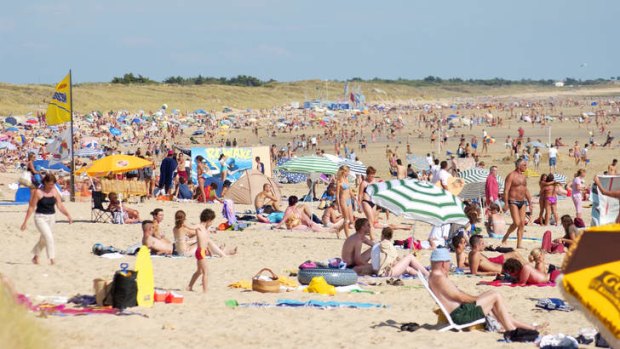
Island cuteness: beach at Ile de Re.Credit: Alamy
With their blend of beaches, cycling and quirky history, the Ile de Re and her island neighbours are great family holiday spots off western France, writes Fred Mawer.
With its long and undeveloped beaches, picture-perfect villages, mouthwatering markets and miles of cycle lanes, the Ile de Re is indisputably one of France's loveliest seaside spots, but also worth considering for a summer break are other nearby islands off the Atlantic coast.
Though very much on the radar of French holidaymakers, they are far less well known to outsiders, even though they share some of the same enticements.
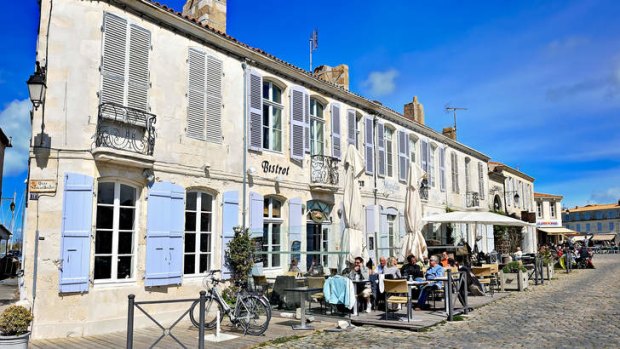
St Martin de Re town.Credit: Alamy
The Ile d'Oleron has memorable beaches great cycling and seafood, but its down-to-earth atmosphere is completely different from fashionable Ile de Re. There's also tiny Ile d'Aix, with more good beaches and cycling, and an intriguing Napoleonic history.
So, which to choose? Here are thumbnail sketches of the three Charente-Maritime islands, for a family holiday.
Most visitors to the islands tend to camp, so we focus chiefly on campsites.
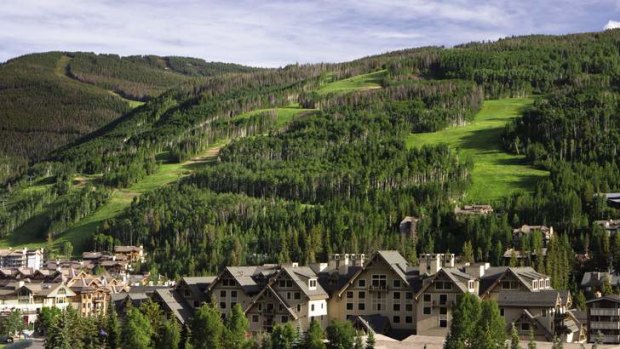
The Vail Valley.
Spending some time on all the islands is very doable: that's what I did with my family. The Ile de Re and Ile d'Oleron are reachable by long bridges, and less than an hour's drive apart. Frequent ferries to the Ile d'Aix depart from Fouras, just off the driving route between Re and Oleron.
ILE DE RE
It's hard to find fault with this island. Virtually every little town and village is preposterously pretty, the countryside - a mixture of marshes, salt pans and vineyards - equally striking. The island's beaches are long and unspoilt.
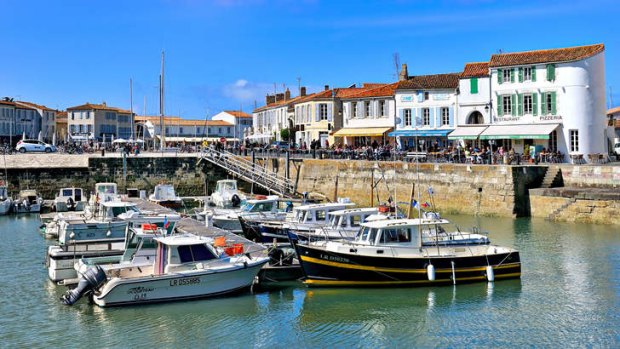
Harbour at Saint Martin de Re.Credit: Alamy
With more than 100 kilometres of cycle lanes, the default means of transport is the bike, which makes exploring great fun. Moreover, the terrain is flat and journeys from campsites to nearby villages and beaches are rarely more than a few miles, so cycling is very much of the pottering, family-friendly kind.
The island is also foodie heaven. Just about every village has a scrumptious food market every morning in the peak summer months, with stalls selling prized local produce, from oysters to salt and samphire to strawberries.
A final selling point: if you get island fever, La Rochelle, one of France's most enjoyable cities is a half-hour drive away.
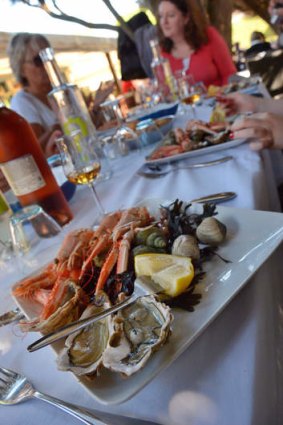
Seafood at Les Paillotes, Ile d'Aix.Credit: Alamy
Drawbacks? Prices are generally high, and to drive across the bridge to the island there's a hefty toll: €16 ($24) in the summer, half that at other times. Also, the island is just a little too chichi for some tastes: on an evening out, it's designer jeans and blue-and-white striped matelot tops.
Beaches Conche des Baleines, in the far west, is the best: a vast, exhilarating arc of golden sand backed by high dunes and pine woods (ideal for a picnic). On the end of the island's north-western hook, the less visited and more protected beach off Bois de Trousse-Chemise is also special, with a vast swathe of wet sand at low tide. Sandy, somewhat featureless beaches run continuously for miles along much of the south coast: at Plage de Gros Jonc, the waves are often great for bodyboarding, but the beaches either side are much less crowded. Note that at high tide all the beaches shrink to thin and sometimes overcrowded strips.
Explorings Must-sees are St-Martin-de-Re, the island's capital, with its chic harbour and tranquil, cobbled backstreets, and nearby La Flotte, smaller, less self-conscious but no less pretty. The best cycling route is in the far west, from La Maison du Fier nature centre to Ars-en-Re, via bird-rich marshes, salt pans and vineyards.
Foods The biggest food market, spreading through much of the village, is at Le Bois-Plage-en-Re; the most scenic is at La Flotte - it occupies a mediaeval courtyard; the quality of the produce (in our humble opinion) is best at Ars-en-Re. Stopping off on a bike ride at a cabane to eat oysters at a picnic table is another essential (and affordable) island experience: the colourful and friendly Cabanajam (cabanajam.blogspot.be) is the most famous cabane. Do also sample home-made ice cream from La Martiniere's parlours in St-Martin-de-Re and La Flotte: the oyster and caviar flavours are an acquired taste. These towns have easily the best choices of restaurants, with menus a little more affordable at La Flotte.
Where to stay We stayed at Camping Interlude (sunelia.com). Pros: direct access to Gros Jonc beach, an indoor/outdoor pool complex and various sports areas. Cons: large, busy site, and wash blocks could be better maintained. Nearby Antioche (camping-apv.com) is smaller, more attractive and peaceful, with access to the beach over dunes. Airotel La Plage (la-plage.com) is a spick-and-span site with good facilities (restaurant, pool), 100 yards from Conche des Baleines beach.
More information
ILE D'OLERON
The island is less pristine and attractive than Ile de Re. Though the architectural style is the same, a lack of building restrictions has resulted in unsightly, commercial development along the main road up the spine of the island, and the countryside is liberally sprinkled with caravans in hedged plots.
After Corsica, the Ile d'Oleron is France's second-largest island - it is 35 kilometres end to end - and its size is another disadvantage over the Ile de Re. For while more than 100 kilometres of cycle lanes pass through fields, pine forests and marshland, distances can be too great to pedal comfortably, so you're often reliant on the car. Moreover, in summer during most daylight hours, the traffic through the island is bumper-to-bumper.
Where the Ile d'Oleron wins out over the Ile de Re is that food - in shops, markets and restaurants - is markedly cheaper, there's no toll on the road bridge from the mainland, and it has nicer campsites.
Beaches On the south-west coast, a colossal sandy beach stretches from Plage de Vert-Bois down to the island's southern tip. It's backed by dunes and pine woods (ideal for shady picnics), has nudist sections, and can be good for surfing. For a more sheltered beach with calm waters, head for Plage de Gatseau, a magical, shell-flecked strand overlooking the channel between the island and the mainland. Or go to the north-east coast: Plage des Saumonards, just north of Boyardville, is a gorgeous spot, reached through pine woods and over dunes. The wooden stakes on the beach, called bouchots, are used for rearing mussels.
Exploring The best off-road cycling is through the Foret des Saumonards. Another option is to cycle, or drive, the Route des Huitres, along the coast north-west from Le Chateau d'Oleron. You can see how Marennes-Oleron oysters - arguably the best in France - are cultivated in former salt pans, there are various places to buy and taste, and, at La Baudissiere, brightly coloured oyster huts have been converted into delightful art studios. Le Chateau d'Oleron, with its vast, waterfront, 17th-century citadel, is the island's most interesting town. Also recommended is a visit to nearby Port des Salines to learn about the once all-important salt production, and climbing the Phare de Chassiron, the splendid black-and-white striped lighthouse on the island's northern tip.
Food Head to La Cotiniere for a meal in one of the fishing port's busy restaurants and to stock up at the gleaming seafood stalls along the front and in the covered market. The stalls are open daily 4-8pm in summer, and sell keenly priced, prepared fruits de mer platters. Le Chateau d'Oleron holds the island's most colourful market (food and other items) on Sunday mornings.
Where to stay We stayed at Domaine d'Oleron (chadotel.com), a peaceful, smallish, well-run site with a decently sized heated swimming pool, cafe and bike hire; the beach at Plaisance is 10 minutes' bike ride away.
The Indigo chain (camping-indigo.com) has two lovely campsites on the Ile d'Oleron that blend beautifully into their environments. Les Pins is set in a pine wood with easy cycling distance of Plage de Gatseau, while Les Chenes Verts spreads over an oak wood directly behind the west coast. At either, you can rent stylish-looking wood-and-canvas pre-erected tents, or bring your own; reserve well ahead.
More information
ILE D'AIX
Croissant-shaped Ile d'Aix is a quaint little place. No motorised vehicles are allowed, and you can cycle right round the island through fields of vegetables and woods, with children in tow, in less than 45 minutes. Most of the 200 permanent inhabitants live in the one and only village, which sits within impressive fortifications built on the orders of Vauban and Napoleon. With frequent ferries from Fouras, and the journey taking just 25 minutes (check service-maritime-iledaix.com), thousands come for the day. But there are options to stay, too.
Beaches A varied selection: good swimming off the long, west-coast beach; pretty rocky/sandy coves backed by woods on the north coast; and a shell-strewn beach on the east-facing bay.
Exploring Take in Place d'Austerlitz - once a military parade ground, now a cypress-shaded grassy square - and the grid of wide streets bedecked with hollyhocks. In 1815, Napoleon spent his last days on French soil in the village's grandest house, now a museum of Napoleana To explore the island, which includes a spooky fort that served as a prison until the 60s, cycling is best. There's a rental depot by the ferry quay, and you can bring your own bikes on the ferry for a small charge.
Food The village and environs have several fairly pricey restaurants, along with simple, takeaway sandwich places for picnics.
Where to stay For a night or two, consider the island's only hotel, the stylish but not especially family-friendly Napoleon (hotel-ile-aix.com). For longer stays, inside Fort de la Rade citadel by the village there's a basic, small campsite and a residence with functional apartments. Renting a house might be preferable.
More information
(including accommodation options above): iledaix.fr.
TRIP NOTES
CAMPING PACKAGES
The Mawer family travelled with Canvas Holidays (canvasholidays.co.uk), staying in a maxi tent at Camping Interlude on the Ile de Re, and Domaine d'Oleron on the Ile d'Oleron. At Camping Interlude, a week in June costs from $410, in August from $1790; at the Domaine d'Oleron, a week in June costs from $440, and in August from $1100. Prices exclude ferry travel.
GETTING THERE
From most Brittany Ferries ports (brittany-ferries.co.uk), Ile de Re is around 4½ hours' drive, Ile d'Oleron an hour more. Other options at discoverferries.com - or fly to La Rochelle (skyscanner.net).
TIPS
The islands are extremely busy throughout July, slightly quieter late August. Island apartments and villas are on homeaway.co.uk. For self-catering, stock up on basic essentials once or twice at a supermarket, then do a bike run every morning to a market for fresh food and treats. There are numerous bike rental outlets on all the islands. In high season, it's best to book well ahead.
Sign up for the Traveller Deals newsletter
Get exclusive travel deals delivered straight to your inbox. Sign up now.